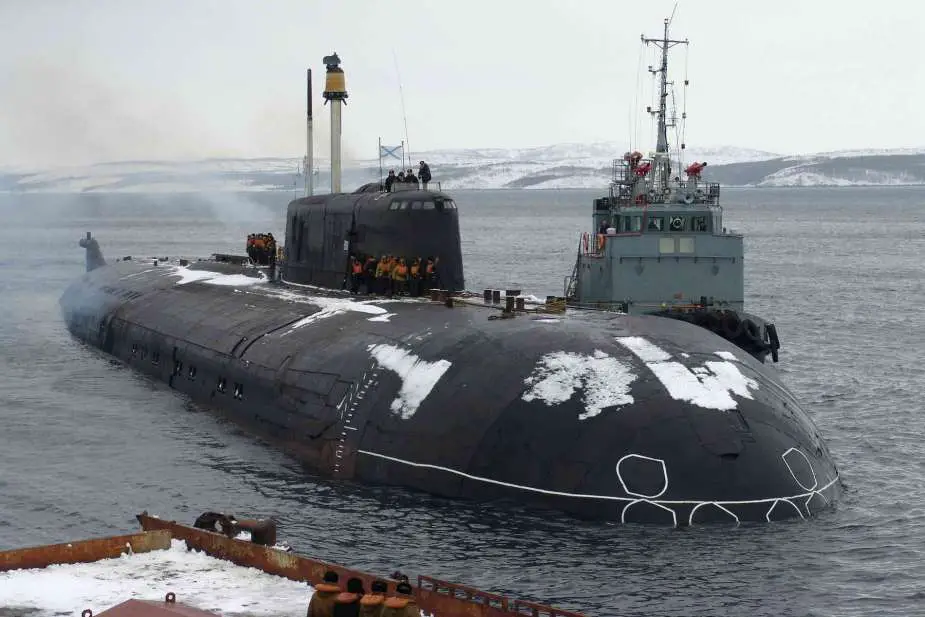Breaking news
Russia to upgrade Project 949A Antey class submarines with Zircon hypersonic missiles.
According to Russian media on January 15, 2024, the Russian Navy announced plans to modernize its Project 949A Antey nuclear submarines. Admiral Viktor Liina, the commander of the Pacific Fleet of the Russian Navy, disclosed the upgrade, which involves equipping these submarines with new missile systems, including Kalibr and Oniks cruise missiles, along with Zircon hypersonic missiles.
Follow Navy Recognition on Google News at this link
 Until 2007, the Project 949 submarines held the distinction of being the largest cruise missile submarines in service. (Picture source: Yandex)
Until 2007, the Project 949 submarines held the distinction of being the largest cruise missile submarines in service. (Picture source: Yandex)
According to Viktor Liina, the modernization of the 949A Antey submarines aims to expand their capabilities to address a broader range of tasks, similar to those of the Yasen and Yasen M-class nuclear submarines, which are currently equipped with Kalibr and Oniks missiles, with plans for the future deployment of Zircon hypersonic missiles.
This modernization decision was initially made in 2017, originally planning to upgrade four out of the eight Project 949A Antey submarines. During this process, the existing launchers on the sides of Project 949A submarines, originally made for the P-700 Granit (SS-N-19 Shipwreck) supersonic cruise missile, are replaced with universal launchers, allowing them to carry three types of missiles, namely Kalibr, Oniks, or Zircon. This upgrade could potentially increase the number of missiles these Project 949A Antey nuclear submarines can carry, with estimates ranging from 24 to either 48 or 72, depending on the sources.
The modernization process is currently in progress at the Far Eastern Zvezda plant, beginning with the nuclear submarine Irkutsk (K-132), where repair and modernization work is being conducted following Project 949AM standards. Following this, the Project 949A nuclear submarine Chelyabinsk (K-442) is scheduled for modernization and conversion to adhere to Project 949AM standards.
The introduction of the Zircon hypersonic cruise missile expands the submarines' operational capabilities. The 3M22 Zircon, also referred to as 3M22 Tsirkon (NATO reporting name: SS-N-33), is a Russian hypersonic cruise missile designed for a variety of roles, including anti-ship, land-attack, and submarine-launched missions.
With dimensions of approximately 9 meters in length and a diameter of 60 centimeters, the Zircon missile carries a warhead capable of accommodating either high-explosive (HE) or nuclear payloads. It features a maximum firing range of 1,000 kilometers and can reach a top speed of Mach 9 (6,900 mph; 11,000 km/h; 3.1 km/s). This high velocity presents challenges to existing missile defense systems, enhancing its effectiveness in penetrating enemy defenses. Additionally, during its hypersonic cruise phase, the Zircon's speed generates a plasma cloud that absorbs radio waves, making it challenging to detect by active radar systems.
The missile's flight profile involves a booster stage with solid-fuel engines for supersonic acceleration, followed by a scramjet motor in the second stage for sustained hypersonic flight. It operates at altitudes of up to 28 kilometers (92,000 feet) and can cover various ranges, ranging from 135 to 270 nautical miles (250 to 500 kilometers) at low altitudes and up to 400 nautical miles (740 kilometers) in a semi-ballistic trajectory.
Admiral Viktor Liina highlighted the modernization potential of Project 949A Antey submarines, stating that they will receive a new missile launcher system, along with updated radio equipment, communications, and service systems. This upgrade aims to position the Soviet-era Project 949A Antey submarines to perform tasks that are comparable to the capabilities of the Yasen and Yasen-M multi-purpose nuclear submarines.
The Oscar class submarines, known as Project 949 Granit and Project 949A Antey by the Soviets and referred to as Oscar I and Oscar II under NATO reporting names, were developed as nuclear-powered cruise missile submarines for the Soviet Navy. They were originally constructed in the 1970s and remain in operational service with the Russian Navy, with plans dating back to at least 2017 for the modernization of two of these submarines under the Project 949AM program. The modernization aims to extend their operational life and enhance their combat capabilities, although the current status of these efforts is uncertain as of 2023.
Until 2007, the Project 949 submarines held the distinction of being the largest cruise missile submarines in service, but their status changed when some Ohio-class ballistic missile submarines were converted to carry cruise missiles. These submarines are the fourth-largest class of submarines in terms of displacement and length, with only the Soviet Typhoon-class, Russian Borei-class, and American Ohio-class ballistic missile submarines being larger.
The Project 949A nuclear-powered submarine has a length of 155 meters, a displacement of 24,000 tons, a maximum submersion depth of 600 meters, and an underwater speed of 32 knots. It is equipped with six torpedo tubes and 24 launchers capable of firing Granit cruise missiles, which have an approximate range of 500 kilometers (311 miles). The submarine is operated by a crew of 107 personnel.


























